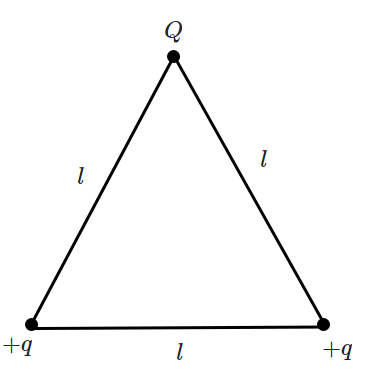Ten electrons are equally spaced and fixed around a circle of radius \(R\). Relative to \(V=0\) at infinity, the electrostatic potential \(V\) and the electric field \(E\) at the centre \(C\) are:
1.
\(V \neq 0 \text { and } \vec{E} \neq 0\)
2.
\(V \neq 0 \text { and } \vec{E}=0\)
3.
\(V=0 \text { and } \vec{E}=0\)
4.
\(V=0 \text { and } \vec{E} \neq 0\)
| 1. | Electric potential at the surface of the cube is zero. |
| 2. | Electric potential within the cube is zero. |
| 3. | Electric field is normal to the surface of the cube. |
| 4. | Electric field varies within the cube. |
Three charges \(Q\), \(+q \) and \(+q \) are placed at the vertices of an equilateral triangle of side \(l\) as shown in the figure. If the net electrostatic energy of the system is zero, then \(Q\) is equal to:
| 1. | \(-\frac{q}{2} \) | 2. | \(-q\) |
| 3. | \(+q\) | 4. | \(\text{zero}\) |
A thin spherical conducting shell of radius \(R\) has a charge \(q\). Another charge \(Q\) is placed at the centre of the shell. The electrostatic potential at a point \(P\) which is at a distance \(\frac{R}{2}\) from the centre of the shell is:
1. \(\frac{\left( q + Q \right)}{4 \pi \varepsilon_{0}} \frac{2}{R}\)
2. \(\frac{2 Q}{4 \pi \varepsilon_{0} R}\)
3. \(\frac{2 Q}{4 \pi \varepsilon_{0} R} - \frac{2 q}{4 \pi \varepsilon_{0} R}\)
4. \(\frac{2 Q}{4 \pi \varepsilon_{0} R} + \frac{q}{4 \pi \varepsilon_{0} R}\)
A charge of \(10\) e.s.u. is placed at a distance of \(2\) cm from a charge of \(40\) e.s.u. and \(4\) cm from another charge of \(20\) e.s.u. The potential energy of the charge \(10\) e.s.u. is: (in ergs)
| 1. | \(87.5\) | 2. | \(112.5\) |
| 3. | \(150\) | 4. | \(250\) |
In a certain charge distribution, all points having zero potential can be joined by a circle \(S\). Points inside \(S\) have positive potential, and points outside \(S\) have a negative potential. A positive charge, which is free to move, is placed inside \(S\). What is the correct statement about \(S\):
| 1. | It will remain in equilibrium | 2. | It can move inside \(S\), but it cannot cross \(S\) |
| 3. | It must cross \(S\) at some time | 4. | It may move, but will ultimately return to its starting point |
Two charges \(q_1\) and \(q_2\) are placed \(30\) cm apart, as shown in the figure. A third charge \(q_3\) is moved along the arc of a circle of radius \(40\) cm from \(C\) to \(D\). The change in the potential energy of the system is \(\frac{q_{3}}{4 \pi \varepsilon_{0}} k\), where \(k\) is:

| 1. | \(8q_2\) | 2. | \(8q_1\) |
| 3 | \(6q_2\) | 4. | \(6q_1\) |
If the dielectric constant and dielectric strength be denoted by \(k\) and \(x\) respectively, then a material suitable for use as a dielectric in a capacitor must have:
1. high \(k\) and high \(x\).
2. high \(k\) and low \(x\).
3. low \(k\) and low \(x\).
4. low \(k\) and high \(x\).
Three capacitors of capacitances \(3~\mu\text{F}\), \(9~\mu\text{F}\) and \(18~\mu\text{F}\) are connected once in series and another time in parallel. The ratio of equivalent capacitance in the two cases \(\frac{C_s}{C_p}\) will be:
1. \(1:15\)
2. \(15:1\)
3. \(1:1\)
4. \(1:3\)
Four capacitors each of capacity \(3~\mu\text{F}\) are connected as shown in the adjoining figure. The ratio of equivalent capacitance between \(A\) and \(B\) and between \(A\) and \(C\) will be:
1. \(4:3\)
2. \(3:4\)
3. \(2:3\)
4. \(3:2\)




